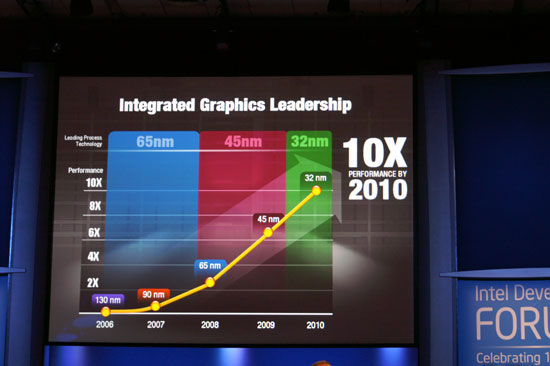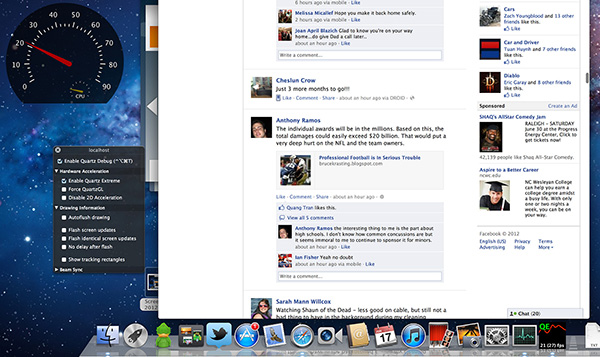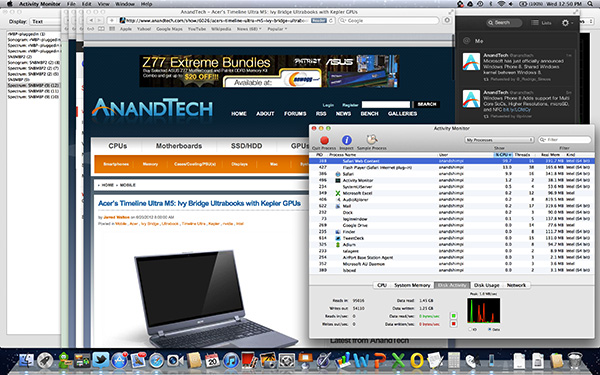The next-gen MacBook Pro with Retina Display Review
by Anand Lal Shimpi on June 23, 2012 4:14 AM EST- Posted in
- Mac
- Apple
- MacBook Pro
- Laptops
- Notebooks
Driving the Retina Display: A Performance Discussion
As I mentioned earlier, there are quality implications of choosing the higher-than-best resolution options in OS X. At 1680 x 1050 and 1920 x 1200 the screen is drawn with 4x the number of pixels, elements are scaled appropriately, and the result is downscaled to 2880 x 1800. The quality impact is negligible however, especially if you actually need the added real estate. As you’d expect, there is also a performance penalty.
At the default setting, either Intel’s HD 4000 or NVIDIA’s GeForce GT 650M already have to render and display far more pixels than either GPU was ever intended to. At the 1680 and 1920 settings however the GPUs are doing more work than even their high-end desktop counterparts are used to. In writing this article it finally dawned on me exactly what has been happening at Intel over the past few years.
Steve Jobs set a path to bringing high resolution displays to all of Apple’s products, likely beginning several years ago. There was a period of time when Apple kept hiring ex-ATI/AMD Graphics CTOs, first Bob Drebin and then Raja Koduri (although less public, Apple also hired chief CPU architects from AMD and ARM among other companies - but that’s another story for another time). You typically hire smart GPU guys if you’re building a GPU, the alternative is to hire them if you need to be able to work with existing GPU vendors to deliver the performance necessary to fulfill your dreams of GPU dominance.
In 2007 Intel promised to deliver a 10x improvement in integrated graphics performance by 2010:

In 2009 Apple hired Drebin and Koduri.
In 2010 Intel announced that the curve had shifted. Instead of 10x by 2010 the number was now 25x. Intel’s ramp was accelerated, and it stopped providing updates on just how aggressive it would be in the future. Paul Otellini’s keynote from IDF 2010 gave us all a hint of what’s to come (emphasis mine):
But there has been a fundamental shift since 2007. Great graphics performance is required, but it isn't sufficient anymore. If you look at what users are demanding, they are demanding an increasingly good experience, robust experience, across the spectrum of visual computing. Users care about everything they see on the screen, not just 3D graphics. And so delivering a great visual experience requires media performance of all types: in games, in video playback, in video transcoding, in media editing, in 3D graphics, and in display. And Intel is committed to delivering leadership platforms in visual computing, not just in PCs, but across the continuum.
Otellini’s keynote would set the tone for the next few years of Intel’s evolution as a company. Even after this keynote Intel made a lot of adjustments to its roadmap, heavily influenced by Apple. Mobile SoCs got more aggressive on the graphics front as did their desktop/notebook counterparts.
At each IDF I kept hearing about how Apple was the biggest motivator behind Intel’s move into the GPU space, but I never really understood the connection until now. The driving factor wasn’t just the demands of current applications, but rather a dramatic increase in display resolution across the lineup. It’s why Apple has been at the forefront of GPU adoption in its iDevices, and it’s why Apple has been pushing Intel so very hard on the integrated graphics revolution. If there’s any one OEM we can thank for having a significant impact on Intel’s roadmap, it’s Apple. And it’s just getting started.
Sandy Bridge and Ivy Bridge were both good steps for Intel, but Haswell and Broadwell are the designs that Apple truly wanted. As fond as Apple has been of using discrete GPUs in notebooks, it would rather get rid of them if at all possible. For many SKUs Apple has already done so. Haswell and Broadwell will allow Apple to bring integration to even some of the Pro-level notebooks.
To be quite honest, the hardware in the rMBP isn’t enough to deliver a consistently smooth experience across all applications. At 2880 x 1800 most interactions are smooth but things like zooming windows or scrolling on certain web pages is clearly sub-30fps. At the higher scaled resolutions, since the GPU has to render as much as 9.2MP, even UI performance can be sluggish. There’s simply nothing that can be done at this point - Apple is pushing the limits of the hardware we have available today, far beyond what any other OEM has done. Future iterations of the Retina Display MacBook Pro will have faster hardware with embedded DRAM that will help mitigate this problem. But there are other limitations: many elements of screen drawing are still done on the CPU, and as largely serial architectures their ability to scale performance with dramatically higher resolutions is limited.
Some elements of drawing in Safari for example aren’t handled by the GPU. Quickly scrolling up and down on the AnandTech home page will peg one of the four IVB cores in the rMBP at 100%:
The GPU has an easy time with its part of the process but the CPU’s workload is borderline too much for a single core to handle. Throw a more complex website at it and things get bad quickly. Facebook combines a lot of compressed images with text - every single image is decompressed on the CPU before being handed off to the GPU. Combine that with other elements that are processed on the CPU and you get a recipe for choppy scrolling.
To quantify exactly what I was seeing I measured frame rate while scrolling as quickly as possible through my Facebook news feed in Safari on the rMBP as well as my 2011 15-inch High Res MacBook Pro. While last year’s MBP delivered anywhere from 46 - 60 fps during this test, the rMBP hovered around 20 fps (18 - 24 fps was the typical range).

Scrolling in Safari on a 2011, High Res MBP - 51 fps

Scrolling in Safari on the rMBP - 21 fps
Remember at 2880 x 1800 there are simply more pixels to push and more work to be done by both the CPU and the GPU. It’s even worse in those applications that have higher quality assets: the CPU now has to decode images at 4x the resolution of what it’s used to. Future CPUs will take this added workload into account, but it’ll take time to get there.
The good news is Mountain Lion provides some relief. At WWDC Apple mentioned the next version of Safari is ridiculously fast, but it wasn’t specific about why. It turns out that Safari leverages Core Animation in Mountain Lion and more GPU accelerated as a result. Facebook is still a challenge because of the mixture of CPU decoded images and a standard web page, but the experience is a bit better. Repeating the same test as above I measured anywhere from 20 - 30 fps while scrolling through Facebook on ML’s Safari.
Whereas I would consider the rMBP experience under Lion to be borderline unacceptable, everything is significantly better under Mountain Lion. Don’t expect buttery smoothness across the board, you’re still asking a lot of the CPU and GPU, but it’s a lot better.











471 Comments
View All Comments
rs2 - Monday, June 25, 2012 - link
...the $2200 one that doesn't include an optical drive and has nowhere to put one. It's not like I want my $2200 device to be usable as an impromptu blu-ray player or anything like that. No, I have money to burn buying extra appliances that do things that my pricey laptop should be able to do, but can't.That's what I might say if I had a hole in my head, at any rate.
rs2 - Monday, June 25, 2012 - link
Also, statements like this seem at least somewhat questionable:"The absence of an integrated Gigabit Ethernet port will surely bother some, but Apple offers a Thunderbolt to GigE adapter for $30 to accommodate."
So Apple leaves out a feature that many people would expect as standard in a high-end laptop, but it's okay because they also happen to sell an optional, paid add-on accessory that provides gigabit ethernet connectivity? Same goes for their $10 power-supply adapter cable.
How about calling them out for trying to nickel-and-dime people to death?
Fx1 - Monday, June 25, 2012 - link
God people like you make me sick.95% of people never used the ethernet port. i would rather than 25% shaved off the profile and weight. 10$ isn't much if your one of the sad people to have to use an ethernet.
Spending £2000 on a laptop I'm not going to care about £7 on a adapter
Spunjji - Tuesday, June 26, 2012 - link
Chill. Either you're sick a lot or you're being hyperbolic...Putting Ethernet in won't increase width by 25%. There are many, many ways to do it and there are thinner laptops out there that support it, even if using hideous dongles. Furthermore there are a wealth of legitimate reasons for wanting it.
Basically what I'm saying is, STFU noob.
Spunjji - Tuesday, June 26, 2012 - link
Yay for paying for baseline features! That adaptor should come as standard with a laptop this expensive. Their penny-pinching with respect to their actual margins is infuriating.ramb0 - Monday, June 25, 2012 - link
Thanks Anand, nice description of what's going on here with the Retina scaling.How is it possible that a 600x600 (for example) image looks better on the rMBP than it does on a standard MBP, and occupies the same amount of screen realestate?
I understand the Backing Scale of 2.0 draws the pixes 4 times more, so therefore appears the same size as on a 1440 screen, but i don't understand how this works for a .jpg image for example.
If it is just using pixel doubling, wouldn't the quality between the "retina" display and normal display be exactly the same, because it is just multiplying each pixel by 4. So essentially you end up with 4 pixels that are the same as each one.
Also, on a separate note, it would be great if you could set the text & UI elements in scale mode of 1680 x 1050 or 1920 x 1200, but keep the "work space" elements as native 2880x1800 (Backing scale 1.0).
wfolta - Monday, June 25, 2012 - link
As I understand it, the image will not look better. Images on disk, say, can look better (because you see pixels you couldn't have seen before). Some websites, like Apple's, will feed you higher-density images than if you were browsing with another machine, and obviously those will look better.Lepton87 - Monday, June 25, 2012 - link
Somehow I doubt that you would be so lenient towards any other company, but if there are glitches in apple hardware it's your fault by your own admission or someone else is at fault. Way to stay neutral and impartial.
Evil_Sheep - Monday, June 25, 2012 - link
Wow, a real bronze medal from Anand! Fewer of these are handed out than Olympic bronze medals in odd-numbered years. And all Apple had to do was innovate and ship a completely revolutionary computing paradigm in displays which, in stark contrast to its PC competition, works virtually flawlessly from day one right down to reprogramming minute graphics routines and on a topic Anandtech has been loudly harping on for years.But never let it be said that Anandtech is too generous with its awards.
Freakie - Monday, June 25, 2012 - link
Hey Anand, or any other employee of the website, aren't there a few parts of this review that very specifically break your traditional object reviews of products and hardware? I mean, it's fine to be excited about something, as Anand is obviously about this laptop, but I think he is so excited that the website's integrity is a little bit compromised. I realize that anyone from the website reading this will recognize that I don't have any right to speak about the integrity of an article written by Anand himself on his own website, but I feel like it should be said anyways, in hopes of keeping your minds clear and objective.It's just things like praising the fact that they got rid of an extra piece of glass on the screen, and how much praise Anand gave for this admittedly stupid thing to point out. As Anand said, this is a matte screen, not a glossy screen, so there being an extra piece of glass in the front would be completely ridiculous, right? The only mention of other matte screens is that those who have used a matte screen in the past are used to not having a protective piece of glass or plastic in between them and when the real LCD starts. Other than that, there isn't anything special about it not having that extra piece of glass. Yet it just baffles me how much Anand goes on about how it has magically been engineered away somehow.
Sorry if I sound pretentiously opinionated. I just really felt that the integrity and methodical reviews that so many people come to Anandtech.com for feels very lacking in this review >_<